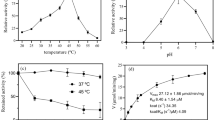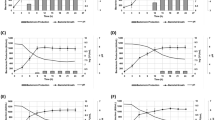Abstract
It has recently been shown that pathogens with a limited capacity for sessile growth (like some Escherichia coli O157 strains) can benefit from the presence of other bacteria and form mixed biofilms with companion strains. This study addresses the question whether pathogens may influence attached growth of E. coli non-pathogenic strains via secreted factors. We compared the biofilm-modulating effects of sterile stationary-phase culture media of a biofilm non-producing strain of E. coli O157:H, a laboratory biofilm-producing E. coli K-12 strain and a biofilm-forming strain of the pathogen Yersina enterocolitica O:3. Sessile growth was monitored as biomass (crystal violet assay), exopolysaccharide (ELLA) and morphology (scanning electron and confocal laser microscopy). With two of the E. coli K-12 strains stimulation of biofilm formation by all supernatants was achieved, but only the pathogens’ secreted products induced biomass increase in some ‘biofilm-deficient’ K-12 strains. Lectin-peroxidase labeling indicated changes in colanic acid and poly-N-acetylglucosamine amounts in extracellular matrices. The contribution of indole, protein and polysaccharide to the biofilm-modulating activities of the supernatants was compared. Indole, in concentrations equal to those established in the supernatants, suppressed sessile growth in one K-12 strain. Proteinase K significantly reduced the stimulatory effects of all supernatants, indicating a prominent role of protein/peptide factor(s) in biofilm promotion. The amount of released polysaccharides (rPS) in the supernatants was quantitated then comparable quantities of isolated rPS were applied during biofilm growth. The three rPS had notable strain-specific effects with regard to both the strain-source of the rPS and the E. coli K-12 target strain.







Similar content being viewed by others
References
Bachmann BJ (1972) Pedigree of some mutant strains of Escherichia coli K-12. Bacteriol Rev 36:525–557
Beloin C, Valle J, Latour-Lambert P, Faure P, Krzeminski M, Balestrino D, Haagensen JAJ, Molin S, Prensler G, Arbeille B, Ghigo JM (2004) Global impact of mature biofilm lifestyle on Escherichia coli K-12 gene expression. Mol Microbiol 51:659–674
Beloin C, Roux A, Ghigo JM (2008) Escherichia coli biofilms. Curr Top Microbiol Immunol 322:249–289
Blango MG, Mulvey MA (2009) Bacterial landlines: contact-dependent signaling in bacterial populations. Curr Opin Microbiol 12:171–181
Bobrov AG, Kirillina O, Forman S, Mack D, Perry RD (2008) Insights into Yersinia pestis biofilm development: topology and co-interaction of Hms inner membrane proteins involved in exopolysaccharide production. Environ Microbiol 10:1419–1432
Burmølle M, Webb JS, Rao D, Hansen LH, Sørensen SJ, Kjelleberg S (2006) Enhanced biofilm formation and increased resistance to antimicrobial agents and bacterial invasion are caused by synergistic interactions in multispecies biofilms. Appl Environ Microbiol 72:3916–3923
Cabellos-Avelar T, Souza V, Membrillo-Hernandez J (2006) Spent media from cultures of environmental isolates of Escherichia coli can suppress the deficiency of biofilm formation under anoxic conditions of laboratory E. coli strains. FEMS Microbiol Ecol 58:414–424
Chen J, Lee SM, Mao Y (2004) Protective effect of exopolysaccharide colanic acid of Escherichia coli O157:H7 to osmotic and oxidative stress. Int J Food Microbiol 93:281–286
Chorianopoulos NG, Giaouris ED, Kourkoutas Y, Nychas GJ (2010) Inhibition of early stage of Salmonella enterica serovar enteritidis biofilm development on stainless steel by cell-free supernatant of Hafnia alvei culture. Appl Environ Microbiol 76:2018–2022
Collet A, Vilain S, Cosette P, Junter GA, Jouenne T, Phillips RS, Di Martino P (2007) Protein expression in Escherichia coli S17-1 biofilms: impact of indole. Antonie Van Leeuwenhoek 91:71–85
Davies PM, Chavez de Paz LE, Svensäter G (2010) Differential effects of Pseudominas aeruginosa on biofilm formation by different strains of Staphylococcus epidermidis. FEMS Immunol Med Microbiol 59:439–446
Dheilly A, Soum-Soutera E, Klein GL, Bazire A, Compere C, Haras D, Dufour A (2010) Antibiofilm activity of the marine bacterium Pseudoalteromonas sp. strain 3J6. Appl Environ Microbiol 76:3452–3461
Di Martino PD, Fursy R, Bret L, Sundararaju B, Phillips RS (2003) Indole can act as an extracellular signal to regulate biofilm formation of Escherichia coli and other indole-producing bacteria. Can J Microbiol 49:443–449
Dubois M, Gilles KA, Hamilton JK, Rebes PA, Smith F (1956) Colorimetric method for determination of sugars and related substances. Anal Chem 28:350–356
Erlandsen SL, Kristich CJ, Dunny GM, Wells CL (2004) High-resolution visualization of the microbial glycocalyx with low-voltage scanning electron microscopy: dependence on cationic dyes. J Histochem Cytochem 52:1427–1435
Fux CA, Stoodley P, Hall-Stoodley L, Costerton JW (2003) Bacterial biofilms: a diagnostic and therapeutic challenge. Expert Rev Anti-infect Ther 1:667–683
Fux CA, Costerton JW, Stewart PS, Stoodley P (2005) Survival strategies of infectious biofilms. Trends Microbiol 13:34–40
Habimana O, Heir E, Langsrud S, Ǻsli AW, Møretrø T (2010) Enhanced surface colonization by Escherichia coli O157:H7 in biofilms formed by an Acinetobacter calcoaceticus isolate from meat-processing environments. Appl Environ Microbiol 76:4557–4559
Hancock V, Witsø IL, Klemm P (2011) Biofilm formation as a function of adhesin, growth medium, substratum and strain type. Int J Med Microbiol. doi:10.1016/j.ijmm.2011.04.018
Hankock V, Dahl M, Klemm P (2010) Probiotic Escherichia coli strain Nissle 1917 outcompetes intestinal pathogens during biofilm formation. J Med Microbiol 69:392–399
Junkins AD, Doyle MP (1992) Demonstration of exopolysaccharide production by enterohemorrhagic Escherichia coli. Curr Microbiol 25:9–17
Klayman BJ, Volden PA, Stewart PS, Camper AK (2009) Escherichia coli O157:H7 requires colonizing partner to adhere and persist in a capillary flow cell. Environ Sci Technol 43:2105–2111
Laue H, Schenk A, Li H, Lambertsen L, Neu T, Molin S, Ullrich M (2006) Contribution of alginate and levan production to biofilm formation by Pseudomonas syringae. Microbiology 152:2909–2918
Lee SM, Chen J (2004) Survival of Escherichia coli O157:H7 in set yogurt as influenced by the production of an exopolysaccharide, colanic acid. J Food Prot 67:252–255
Lee J, Bansal T, Jayaraman A, Bentley WE, Wood TK (2007a) Enterohaemorrhagic Escherichia coli biofilms are inhibited by 7-hydroxyindole and stimulated by isatin. Appl Environ Microbiol 73:4100–4109
Lee J, Jayaraman A, Wood TK (2007b) Indole as an inter-species biofilm signal mediated by SdiA. BMC Microbiol 7:42. doi:10.1186/1471-2180-7-42
Leriche V, Sibille P, Carpentier B (2000) Use of an enzyme-linked lectinosorbent assay to monitor the shift in polysaccharide composition in bacterial biofilms. Appl Environ Microbiol 66:1851–1856
Lopes SP, Machado I, Pereira MO (2011) Role of planktonic and sessile extracellular metabolic byproducts on Pseudomonas aeruginosa and Escherichia coli intra and interspecies relationships. J Ind Microbiol Biotechnol 38:133–140
Macleod SM, Stickler D (2007) Species interactions in mixed-community crystalline biofilms on urinary catheters. J Med Microbiol 56:1549–1557
Mao Y, Doyle MP, Chen J (2001) Insertion mutagenesis of wca reduces acid and heat tolerance of enterohemorrhagic Escherichia coli O157:H7. J Bacteriol 183:3811–3815
Mao Y, Doyle MP, Chen J (2006) Role of colanic acid exopolysaccharide in the survival of enterohaemorrhagic Escherichia coli O157:H7 in simulated gastrointestinal fluids. Lett Appl Microbiol 42:642–647
Marouani-Gadri N, Augier G, Carpentier B (2009) Characterization of bacterial strains isolated from a beef-processing plant following cleaning and disinfection—influence of isolated strains on biofilm formation by Sakaï and EDL 933 E. coli O157:H7. Int J Food Microbiol 133:62–67
Matthysse AG, Deora R, Mishra M, Torres AG (2008) Polysaccharides cellulose, poly-β-N-acetyl-d-glucosamine, and colanic acid are required for optimal binding of Escherichia coli O157:H7 strains to alfalfa sprouts and K-12 strains to plastic but not for binding to epithelial cells. Appl Environ Microbiol 74:2384–2390
May T, Okabe S (2008) Escherichia coli harboring a natural IncF conjugative F plasmid develops complex mature biofilms by stimulating synthesis of colanic acid and curli. J Bacteriol 190:7479–7490
Miyazaki Y, Kamiya H, Hanawa T, Fukuda M, Kawakami H, Takahashi H et al (2010) Efect of probiotic bacterial strains of Lactobacillus, Bifidobacterium, and Enterococcus on enteroaggregative Escherichia coli. J Infect Chemother 16:10–18
Prigent-Combaret C, Prensier G, Le Thi TT, Vidal O, Lejeune P, Dorel C (2000) Developmental pathway for biofilm formation in curli-producing Escherichia coli strains: role of flagella, curli and colanic acid. Environ Microbiol 2:450–464
Prüß BM, Besemann C, Denton A, Wolfe AJ (2006) A complex transcription network controls the early stages of biofilm development by Escherichia coli. J Bacteriol 188:3731–3739
Reisner A, Hölter B, Molin S, Zechner EL (2006a) Synergistic effects in mixed Escherichia coli biofilms: conjugative plasmid transfer drives biofilm expansion. J Bacteriol 188:3582–3588
Reisner A, Krogfelt KA, Klein BM, Zechner EL, Molin S (2006b) In vitro biofilm formation of commensal and pathogenic Escherichia coli strains: impact of environmental and genetic factors. J Bacteriol 188:3572–3581
Rendueles O, Travier L, Latour-Lambert P, Fontaine T, Magnus J, Denamur J, Ghigo JM (2011) Screening of Escherichia coli species biodiversity reveals new biofilm-associated antiadhesion polysaccharides. mBio 2(3). doi:10.1128/mBio.00043-11
Rieu A, Lemitre JP, Guzzo J, Piveteau P (2008) Interactions in dual-species biofilms between Listeria monocytogenes EGD-e and several strains of Staphylococcua aureus. Int J Food Mirobiol 126:76–82
Simões LC, Simões M, Vieira MJ (2011) The effects of metabolite molecules produced by drinking water-isolated bacteria on their single and multispecies biofilms. Biofouling 27:685–699
Stoitsova S, Ivanova R, Dimova I (2004) Lectin-binding epitopes at the surface of Escherichia coli K-12: examination by electron microscopy, with special reference to the presence of a colanic acid-like polymer. J Basic Microbiol 44:296–304
Stoodley P, Sauer K, Davies DG, Costerton JW (2002) Biofilms as complex differentiated communities. Annu Rev Microbiol 56:187–209
Uhlich GA, Rogers DP, Mosier DA (2010) Escherichia coli serotype O157:H7 retention on solid surfaces and peroxide resistance is enhanced by dual-strain biofilm formation. Foodborne Pathog Dis 7:935–943
Valdez JC, Peral MC, Richard M, Santana L, Perdigon G (2005) Interference of Lactobacillus plantarum with Pseudomonas aeruginosa in vitro and in infected burns: the potential use of probiotics in wound treatment. Clin Microbiol Infect 11:472–479
Valle J, Da Re S, Henry N, Fontaine T, Balestrino D, Latour-Lambert P, Ghigo JM (2006) Broad-spectrum biofilm inhibition by a secreted bacterial polysaccharide. Proc Natl Acad Sci USA 103:12558–12563
Wood TK (2009) Insights on Escherichia coli biofilm formation and inhibition from whole-transcriptome profiling. Environ Microbiol 11:1–15
Yeh JY, Chen J (2004) Production of slime polysaccharide by EHEC and STEC as well as the influence of culture conditions on slime production in Escherichia coli O157:H7. Lett Appl Microbiol 38:488–492
Acknowledgments
This study was supported by the National Research Fund, Republic of Bulgaria, Contract DO02-301. The purchase of the CLSM facility due to Contract IFS-B-603, and the access to a novel SEM facility due to Contract DO02-56 with the National Research Fund, Republic of Bulgaria, is thankfully acknowledged. Thanks are due to Mr O. Stoitsov, MA in English language, for corrections of the English text.
Author information
Authors and Affiliations
Corresponding author
Rights and permissions
About this article
Cite this article
Vacheva, A., Ivanova, R., Paunova-Krasteva, T. et al. Released products of pathogenic bacteria stimulate biofilm formation by Escherichia coli K-12 strains. Antonie van Leeuwenhoek 102, 105–119 (2012). https://doi.org/10.1007/s10482-012-9718-y
Received:
Accepted:
Published:
Issue Date:
DOI: https://doi.org/10.1007/s10482-012-9718-y




